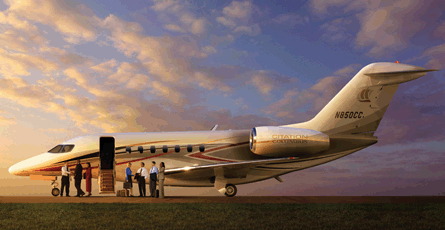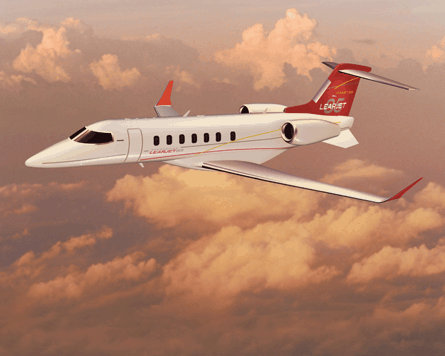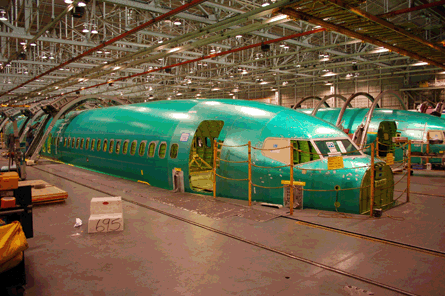The Wichita aerospace cluster is the story of a city transformed by a global economic downturn that saw near-collapse in the credit market, slowing corporate profits and a headwind of public opinion that branded business aircraft as luxury jets and foolish expenditures for the dalliances of the ultra-wealthy.
To talk about the changing fortunes in the industry is to talk about the fluctuating fortunes of the city of Wichita and its chief export, business aircraft.
"We are velcroed to them," says Suzie Alhstrand, vice-president of community advancement for the Wichita Metro Chamber of Commerce, speaking of the city's relationship to the aircraft makers.
Business jet deliveries from Wichita manufacturers Cessna, Hawker Beechcraft and Bombardier's Learjet line are estimated to fall by 42% in 2009 to 398 aircraft, from 696 in 2008 versus about a 9% drop for business aircraft manufacturers outside Wichita, according to UBS Investment Research.
 |
|---|
© Hawker Beechcraft |
The city has seen aerospace jobs drop by 19.3% from July 2008 to July 2009, according to data from the Wichita Metro Chamber of Commerce, which closely tracks the city's economic indicators. Since then, that number has continued to rise with layoffs among the major airframers topping 13,000 by some estimates, although the job losses are far more extensive, with associated suppliers and supporting businesses making staff cuts as well.
The past 12 months could not be more different from the 12 that preceded them in 2008, largely considered to be a banner year for Wichita. The Cessna Columbus and Hawker 450XP were launched, Spirit AeroSystems won significant contracts to produce parts of the Gulfstream G650, G250 and Cessna Columbus, while Hawker Beechcraft certificated and delivered its first Hawker 4000 and Bombardier announced that final assembly for its Learjet 85 would be in Wichita.
As NBAA 2008 was getting under way, the US stock market was fluctuating wildly as the foundations of the global economy were coming unhinged. A year later, manufacturers have responded by shelving new products, making cuts in production and even deeper cuts in the workforce, with layoff estimates ranging as high as 50% for some companies.
Just weeks after NBAA 2008, manufacturers pushed toward the end of the year unsure of what 2009 would bring.
However, this is only half the story. The jobs lost are extremely painful for the families, their employers and the city, but those that remain are entrusted with the stewardship of and survival of the company. The downturn has accelerated tactical and strategic changes in the way the companies operate as they work to weather the storm.
As the recession stretches beyond one year, the pillars of the Wichita aerospace cluster, Bombardier, Cessna, Hawker Beechcraft and Spirit AeroSystems have worked to adapt to the realities of a difficult marketplace.
CESSNA
Cessna has reduced its workforce by 50% and has been most hard hit by the downturn. The company employed more than 15,000 people in 2008, according to its website.
Shortly after NBAA 2008, on 29 October, the company broke ground on a $200 million 55,760m² (600,000ft²) facility in Wichita that was to house final assembly operations for the company's large-cabin Citation Columbus business jet creating up to 1,000 new jobs. The jet, which was unveiled in February 2008, represented a major expansion of Cessna's product line in the large and super-midsize category, taking on Dassault's Falcon 2000EX and Bombardier's Challenger 605.
 |
|---|
© Cessna |
Days after the groundbreaking on 4 November, Cessna announced that it would slow production on its Citation jet lines while attempting to offset some losses by continuing ramping up its Citation Mustang production.
By April the company had already announced major reductions in its workforce, and along with the major drop in demand for business aircraft, Cessna was forced to suspend development of the Columbus.
"This was a very difficult decision, but critical to sizing our business to the realities of today's market," said Cessna president Jack Pelton at the time. "We still feel this is a programme with great potential and one we will pursue when the market recovers."
However, by July, Cessna had quietly cancelled the Columbus programme in a regulatory filing, citing unfavourable current market conditions.
In the midst of the deep cuts, Cessna has opted to focus on development of its Citation CJ4, set for service entry in 2010. In addition, it delivered its first Citation X equipped with aftermarket elliptical winglets that boost range by as much as 280km (150nm) and reduce fuel burn by 4-5% on long-range missions.
BOMBARDIER
Of the Wichita business jet makers, Bombardier's Learjet line has seen a substantial, yet modest by comparison, cut in its local staff, with a total reduction of about 14% of its 2,500 person workforce. The cuts came as part of a 4.5% reduction in the global Bombardier workforce of 30,000 announced in February.
The collapse of Jet Republic in August has meant the evaporation of a record order for up to 110 Learjet 60XRs valued at $1.5 billion, and has left Bombardier scrambling to find owners for the 25 firm 60XR orders.
For the newest member of the Bombardier business aircraft family, the composite Learjet 85 is a point of opportunity for Wichita, home to its final assembly, interior completions, painting and test-flight operations. The Model 85 will be largest member of the Learjet family, competing with the Citation Sovereign, Gulfstream G150 and Hawker 900XP.
 |
|---|
© Bombardier |
Bombardier has also partnered Wichita's National Institute for Aviation Research, which will build structural test rigs and perform certification of the "pre-preg" composite materials.
Bombardier said at NBAA in 2008, before announcing its layoffs, that the Learjet 85 would generate 150-200 new recruits at its Montreal and Wichita facilities. Service entry is planned for 2013.
HAWKER BEECHCRAFT
Hawker Beechcraft's 2009 has mirrored that of Cessna's, with significant reductions in the workforce. The company declined to disclose the total size of the reduction, which is estimated between 30% and 35% of its roughly 10,000-person workforce.
Hawker Beechcraft operations have been able to fall back, in part, on the special mission aircraft offering that build on existing products. In July, the company launched the King Air C90GTx that includes new composite winglets and provides increased payload by 175kg (385lb) and will fly up to 400km farther than the company's C90GTi model.
Even with these bright spots, Hawker Beechcraft has seen significant deferrals from fractional operators such as NetJets, putting the future of projects like the re-engined Hawker 450XP in question.
The downturn "creates the opportunity to act with a sense of urgency, treating every customers as if they are in competitive jeopardy", says Shawn Vick, Hawker Beechcraft executive vice-president.
 |
|---|
© Hawker Beechcraft |
Yet in the wake of the cuts, the company has used the downturn to "get back to basics" when it comes to its manufacturing operations, says Bill Brown, executive vice-president for global operations.
"We've reassessed everything in our business," says Brown, adopting two major initiatives to cut cost and use its manufacturing capacity. Brown says that the changes had always been planned, but the implementation was accelerated when the downturn struck.
The first, Brown says, is to cross-train the smaller workforce, which has more experience due to its seniority, in different competencies to be used across the assembly process. For example, a riveter previously assigned to a specific area of an aircraft is now expanding responsibility by riveting across the aircraft, adapting to the different tolerances in different areas. In addition, a worker who previously focused on wiring aircraft is now handling the plumbing and interior installation as well.
The second initiative, Brown says, is geared toward evaluating the company's manufacturing capacity and volumes. In some instances, Hawker Beechcraft has sought to take on additional work from outside. For example, if a certain tool was being used at 50% of capacity, Brown says, Hawker Beechcraft has partnered other suppliers with similar available capacity to consolidate and insource work.
The company has also revamped aspects of its assembly procedures. It is now pre-drilling its composite Hawker 4000 centre fuselage sections out of sequence before mating, making the installation of parts like the wing-to-body go much faster.
In addition, pre-stuffing of forward sections with windshields and cockpit fitting have eliminated potential bottlenecks if rework had been required later on in the assembly process.
Brown says the company has been able to save $13,000 a week on the Hawker 4000 assembly line.
Hawker Beechcraft also created a team of 26 people that would have otherwise been laid off as part of an initiative called Project Fix It to improve graphical work instructions, tooling and processes. Brown says that there were 31 processes spread across the King Air, Hawker 900 and 4000 lines that were standardised by creating a universal process document to streamline operations. "We're really getting back to basics," says Brown.
SPIRIT AEROSYSTEMS
As the business aircraft makers have responded to the downturn, Spirit AeroSystems has been able to carry on unscathed amid the deep cuts in the Wichita aerospace cluster. The shrinking workforces of Bombardier, Cessna and Hawker Beechcraft have positioned Spirit as the largest single aerospace employer in Wichita, with a staff of about 10,500.
Yet over the last year as it has watched cuts being made at companies around it, Spirit has pre-emptively made adjustments to its operations with the potential for future production cuts on the commercial side of the business, which has yet to experience a downturn like that of business aviation.
Around the time the recession hit in September 2008, Spirit instituted a hiring freeze in conjunction with Boeing's machinists' strike and the uncertainty on the 787 programme. Along with the freeze, the company went to shorter work weeks for a time, until Boeing production was back up and running. As the company has leaned its workforce through attrition, Spirit has opted for increasing overtime to strategically understaff existing programmes.
 |
|---|
© Spirit Aerosystems |
Buck Buchanan, Spirit's chief operating officer, says it was a risky move, but one that has ultimately paid off for the company and the workforce. With the hiring freeze still in effect at Spirit, the company has stretched overtime hours as it is undermanned, allowing a scaling back of those overtime hours first if rates drop on 737, as they expect them to next year.
Yet the aerostructures manufacturer was had a direct hit when Cessna cancelled its Citation Columbus programme, for which Spirit was responsible for fabrication of the complete fuselage and empennage at Wichita.
Of its direct business aircraft content, Spirit is responsible for the Rolls-Royce BR725 engine nacelle for the Gulfstream G650 built in Wichita and the wing of the G650 and G250, both fabricated in Tulsa, Oklahoma facility.
However, based on its core commercial aircraft business, Spirit's exposure to the business aircraft market is indirect as it produces fuselages for Boeing's 737 passenger jet, which also serves at the platform for the Boeing Business Jet family of aircraft. Spirit also produces aerostructures for the Boeing 747, 767 and 777, as well as the Airbus A320 and A380, all of which are available in VIP configuration.
Boeing is to reduce the 777 production rate from seven to five a month, starting in June 2010, and will put on hold proposed ramp-ups on the 747 and 767. If the company had continue hiring, Spirit would have added another 250-300 staff, only to lay them off later when the rates came down. Instead, with the hiring freeze in place, Buchanan says that Spirit was able to scale back without layoffs.
Spirit, Buchanan says, has seen the hardship endured by the companies that surround them in Wichita and has sought to avoid the deep cuts. "We feel like we're behaving differently from the way a normal aerospace company would behave, because we look down the road and forecast a little more long range than what's right in front of us."
Heading into 2010, the picture is far less certain. Spirit believes that a rate cut on 737 is likely, following Boeing's pattern of significant production cuts every 10 years, although Boeing maintains that its narrowbody rates are holding steady. In the event of such a cut on the 737, which accounts for 50-60% of its Wichita workforce, depending on the status of the 787 programme, Spirit would first opt to begin reducing overtime, then go to shorter working weeks, ultimately with the goal of avoiding layoffs as best as possible, Buchanan says.
As a result of the shorter working weeks and other workforce changes hitting not only the aerospace industry in Kansas, companies have sought to form public/private partnerships to reshape unemployment policy.
Kansas state Representative Raj Goyle, whose East Wichita district includes Hawker Beechcraft, sponsored legislation that expands not only benefits to the unemployed, but now provides employees on shorrt time the opportunity to attend state-approved job training programmes to learn new skills.
Goyle says the bill, which was signed into law in May, is designed in partnership with local Wichita companies and can be applied beyond the aerospace industry. The policy was made possible by tapping $69 million of funding through the Kansas Unemployment Insurance Trust Fund, from which benefits are paid. The $69 million was part of the $787 billion in economic stimulus funding passed by the US Congress in February.
"This was a big win for worker and businesses. It's an excellent example of how public-private partnerships can work. Wichita and Kansas will bounce back," says Goyle.
INTO 2010
Prospects for 2010 appear to provide little forecast for recovery, with estimates for Wichita deliveries falling to 340, or 14% from 2009, or almost 51% from 2008 levels, says UBS.
"I think we have another challenging year coming up. We know things we can control and we know things we can't control, I think the economy will continue to straighten itself out. I think in our area, we're going to face another demanding year," says Bryan Derreberry, president and chief executive of the Wichita Metro Chamber of Commerce.
With the second highest manufacturing employment per capita in the USA, one in 10 jobs in Wichita support the aerospace industry. Cyclical pain endured by the city every time a downturn hits the aerospace industry is prompting it to expand its economy beyond aviation, leveraging its aerospace expertise.
"How can we find those emerging industries that are closely aligned with what we do here well already? How can we build some diversity and strength into the economy through those emerging clusters? When you're in the middle of the firing zone, sometimes it's the best time to look at economic drivers. What are their immediate and long-term prospects?" asks Derreberry.
In May, Wichita State University and Via Christi Health System announced a $20 million grant to support the Center of Innovation for Biomaterials in Orthopaedic Research, which hopes to leverage the expertise in composite materials for aerospace to the biomedical world for implantable devices such as hip replacements.
Yet even as the city looks to diversify, aerospace is still at its heart .
"It's a stressful and emotional time," says Hawker Beechcraft's Brown. "Look at a company in survival mode and you have to do the right things to survive. We're going to survive. It's the responsibility of those that are staying to keep the company alive. When people come back they'll see a different company."
Source: Flight International



















